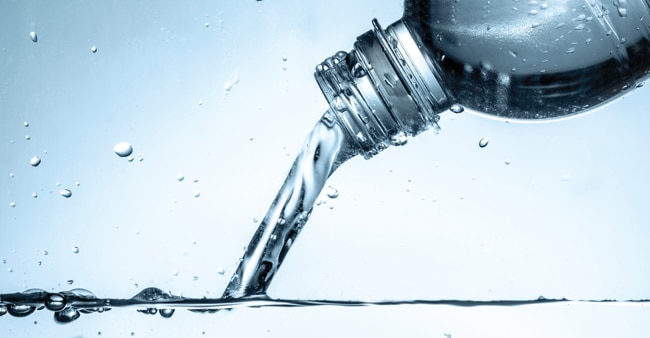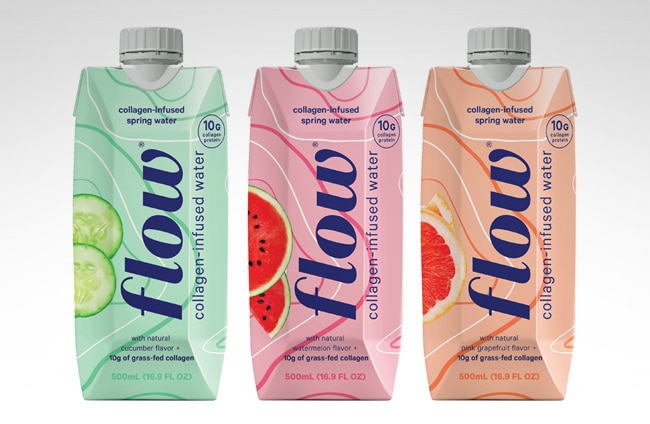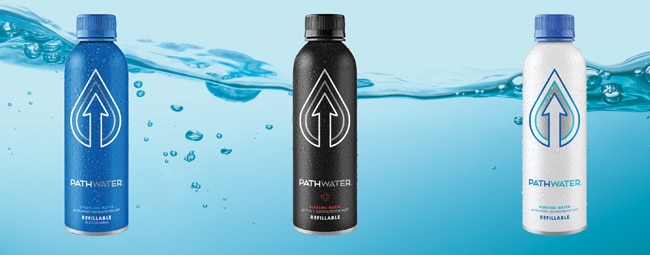Message in a Bottle
“Bro I love you but wtf on the water bottle. No single use plastic. Come on.”
With that inelegant but direct comment, written in response to an Instagram post by “Jurassic World” star Chris Pratt in which the actor holds a plastic water bottle during a workout, actor Jason Momoa summed up the feelings of many when it comes to single-use plastic bottled water.
It may have been somewhat self-serving — after all, the “Aquaman” star has his own brand of still water in aluminum cans, Mananalu — but it also indicates how a generation of consumers that helped make bottled water the most popular beverage in the U.S. is now reflecting on the broader impact of that change.
The scope of the challenge can easily become overwhelming. Packaging alone comprises a complex set of interlocked and competing formats, each carrying its own balance of positive and negative factors. And though it may resonate strongly with consumers, other factors — such as sourcing, carbon footprint and use of shipping materials — can sometimes outweigh the benefits of alternative packaging options. Even if those issues can be solved, materials still need to enter a recycling stream that has been left antiquated and underfunded in many areas across the country.
Tackling the problem in normal conditions is a daunting challenge; in the wake of the global economic disruption caused by the COVID-19 pandemic, it’s unlikely to become easier. The outbreak is already helping to pump up sales in the U.S. even more that usual: according to data from SPINS, shelf-stable water was up 6.1% over the last four weeks, with non-carbonated water up 2.1% ($59.8 million) during that time.
Still, there’s hope yet. Taking the form of both ambitious programs and subtle adjustments, sustainability and environmental considerations are taking an increasingly prominent role in how large corporations and emerging independent brands are approaching the bottled water market in the new decade.
BALANCING THE EQUATION
Though packaging is often the focus, creating a more sustainable and eco-friendly bottled water industry involves weighing a wide range of factors beyond that.
Most bottled water products are made with polyethylene terephthalate (PET), and there’s a good reason for that: it’s shatter-proof, lightweight, versatile and recyclable. Manufacturing — in which crude oil and natural gas are heated and molded into containers — requires a relatively low carbon output, and bottles can be recycled via most municipal recycling programs.
Considering the category’s continuous growth, there should theoretically be plenty of recycled PET (rPET) to eliminate the need for sourcing virgin plastic. Yet according to the EPA, only 29.1% of PET bottles in the U.S. were recycled in 2017, while that same year landfills received 26.8 million tons of plastic waste.
Of those bottles that are recycled, less than 10% are turned back into usable containers — which, though consuming less energy than first-time plastic, must also be melted down into chemical form and remolded. If the process of cleaning and sorting plastic bottles at recycling centers doesn’t yield an output of high quality food-grade rPET, the amount of input into those centers doesn’t make much difference.
If you’re looking to go outside PET, aluminum has its advantages. The material is easy and efficient to recycle and enjoys a higher recycling rate in the U.S. than glass, plastic and cartons, meaning it’s less likely to end up as ocean waste. According to data from the Environmental Protection Agency (EPA), cans contain 68% recycled content compared to just 3% for plastic.
Yet it comes at a cost: producing one can emit twice as much carbon into the atmosphere as a plastic bottle. According to an analysis by Reuters, an aluminum can can be responsible for 1,300 grams of carbon dioxide emissions — about the equivalent of driving a car 7 to 8 kilometers — at its most polluting level, while a PET bottle of equal size accounts for 330 grams.
Other format options include Tetra Pak cartons, as brought to prominence by Boxed Water is Better, JUST Water and Canadian brand Flow. The format is lightweight, easy to ship and stands out on store shelves amongst other bottled water options. However, though they are accepted by many local collection programs, Tetra Paks can only be recycled at a limited number of sites in North America, and municipalities are responsible for transporting them. Once there, the plastic, paper and aluminum layers must be mechanically separated before being converted into usable material.
Whatever the packaging may be, there are more complex challenges to overcome, such as responsible water sourcing and minimizing emissions from transporting products. Even for environmentally conscious consumers, trying to weigh all the factors and make a responsible choice at the bottled water cooler can be difficult.
“If we only focus on recycling, which many companies in this space do, there’s a major issue there,” said Ira Laufer, CEO of JUST Water. “It doesn’t matter what your product is made of — if at the end of the day consumers don’t put that package in the right bin, how is it helping us as a recyclable product?”
Instead, Laufer said, JUST Water is focusing its messaging on “the entire [package] lifecycle.” The brand markets unflavored and flavored still water in a Tetra Pak that is made from 88% renewable material (up from 54% when the company launched),
“We look at things from a more holistic way: What does it take to create the product? What sort of environment impact does the process have? What does it take to make an aluminum product and what does it take to make a JUST product?,” he said.
As the bottled water market continues to add more alternative packaging options, Laufer is betting that consumers and hospitality partners will recognize JUST Water’s long-standing bonafides as a mission-driven brand.
“I have not yet seen the data to support so many aluminum cans coming into the market,” he said. “I don’t think consumers are buying into that concept. We are being consistent — this is what the brand has always stood for.”
CHANGING HABITS
If long-term targets for boosting recycling and cleaning up the oceans are to be met, the effort will be carried in significant part by the changing habits of younger consumers.
PathWater, which markets still and sparkling water in reusable aluminum bottles, is one of a number of growing water companies building around that cause. Led by co-founders Ali Orabi and Shadi Bakour, both named to Forbes’ 30 Under 30 Social Entrepreneurs list for 2020, the brand has turned its packaging into a reason not only for stores to take it in but for them to take other products out. Last year, the company helped convince San Francisco International Airport to ban the sale of single-use plastic water bottles.
“These large-scale partnerships are allowing us to really shake up what has been known as a typical bottle water offering across everything from retail, organization, hospitals, airports, schools,” said Bakour. “For us, what we always say on the bottle is that we are ‘proud partners in saving the planet.’”
The partnerships are also an important tool to build awareness and promote changes in personal behavior — recycling more, being the obvious one — that can have positive long-term impact on the environment. PathWater has worked with corporations like Adidas, Lockheed Martin and Salesforce to create custom co-branded products, while JUST Water has also leveraged partnerships as an alternative route to market that fit with the brand’s core mission.
“It’s all about the partnerships and working with the other organizations and other partners that appreciate what we do as a company,” said Laufer. “It gives us an opportunity to partner with them and create education and awareness. Our biggest growth has not been from retail — that’s a small part of our business in general. This is where we have been investing most of our efforts because that’s where we can make the best impact.”
More simply put, caring about the environment is very much on-trend.
“Brands pay a lot of money for influencers and events and to get their name out there, but for us it has been the opposite,” said Bakour. “People and organizations are trying to promote themselves through us. We’re being approached by all these people because they want to show that they care about the environment and PathWater is the perfect way to do that.
Like with sugar, trans fats and artificial colors previously, the backlash against plastic has also provided some brands with potent material with which to shape marketing campaigns. For its tongue-in-cheek “Keep the Underworld Beautiful” campaign, Liquid Death, which markets a heavy-metal inspired line of still and sparkling spring water in 16 oz. cans, showcases a hellish “underworld” overflowing with single-use plastic bottles (“Demon turtles ingest more plastic than flesh,” it warns).
Brands offering alternative packaging have also benefited from the backing of notable influencers. Momoa isn’t the only one: Jayden Smith is one of JUST Water’s co-founders, Flow Water counts actress and wellness guru Gwenyth Paltrow as a brand ambassador and PathWater’s investors include former NFL star Vernon Davis and celebrity chef Guy Fieri, among others.
Whether it’s one more person recycling their can of Liquid Death or one more individual reusing their bottle of PathWater, it can be important to recognize incremental progress made against the sprawling challenge of making bottled water more sustainable. Brands in the space are one cog in a massive machine, one which will require a collective public and private effort to make hay.
“It’s going to take a lot more than what we are doing to educate consumers when they go buy the shelf and they see a bunch of different items,” said Laufer. “It’s really challenging to find a way to provide all this information in such a short moment when they need to make a buying decision. It will take more than what we are capable of as a company.”


Receive your free magazine!
Join thousands of other food and beverage professionals who utilize BevNET Magazine to stay up-to-date on current trends and news within the food and beverage world.
Receive your free copy of the magazine 6x per year in digital or print and utilize insights on consumer behavior, brand growth, category volume, and trend forecasting.
Subscribe

